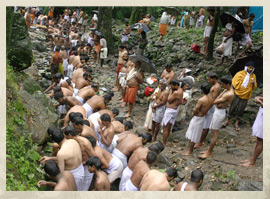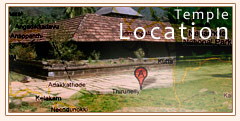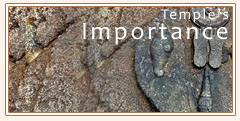Rituals and offerings

The flow of the pilgrims to Thirunelli Temple is not only to offer
prayers but also to perform the ancestral rites called Bali. Those who
do the rites have to observe penance. In Kerala it is in Thirunelli
Temple, the largest number of ‘bali tharpana’ is being performed
everyday.
It is desirable that those who come for ancestral rites may reach the temple on the eve itself, so that they can conveniently pay the fee at the Devaswam Counter and get the receipt. The fee is to be paid in the name of the performer and not in the name of the deceased.
It is desirable that those who come for ancestral rites may reach the temple on the eve itself, so that they can conveniently pay the fee at the Devaswam Counter and get the receipt. The fee is to be paid in the name of the performer and not in the name of the deceased.
When one person alone is performing the rites, it is called “oraalpindam”. But one who has remitted the fee for “oraalpindam” can do the obsequies for all the dead ancestors of the ‘tharavaad’ whom he knows and not knows. The fee for “oraalpindam” is Rs 43. This include Rs.35, the share to Thirunelli Temple and Rs.8, the share to Thrissilery Temple (for vilakkumaala). There is facility for the related family members also to sit together and do the rites along with the main performer. This is called “koottupindam”. For this the main performer (the Kaaranavar of the tharavaad) has to remit Rs.43 and each member Rs.30 each.
After getting the receipt, the performers have to stand at the temple step, taking bath. Immediately after “deepaaraadhana’ the “Vaadhayaar” (the Priest) will dictate the prayer for all those who have assembled on the step. The performers have to recite this prayer. After the prayer, they have to do “dandanamaskaara”(to prostrate, by falling down at full length) before Thirunelli Perumaal and pay the “kaanikka” (offering). With the above, the rituals to be done on the eve of ancestral rites, come to a close.
Next day without taking bath, between 6 am and 11 am, the performers have to reach the temple and collect the “bali materials” and “dharbha grass” from the special counter arranged on the northern side of the temple, showing the receipt.
After this, they head to the pond, in the sacred stream called Papanashini, located about half a kilometer away, in the forest. There, it will be waist deep water. Now take the first dip in the water, before the actual ritual starts.
On the bank of the pond stands the “Vaadhyaar” (the priest) who administers the ritual. Pilgrims line in the stream with almost ankle-deep flowing water. The ritual material collected from the temple is placed on the boulder in front, and the priest directs and administers the rituals in sequence.
Then they have to return to main temple after praying to Lord Shiva in the “Gunnika Temple”. The rituals come to a close with the reverential circumlocution around the main Temple, worship of the “Perumaal” there and receipt of the “thirmadhura Nivedyam” “theertham” and “Prasaadam”. Those who have the statues with them have to return the same in the counter. Even if one fails to reach the temple on the eve, can perform the rites, the same day, provided they arrive the temple before 11 am.
Thirunelli and Thrissilery temples are closely connected. The traditional ritual is that those who perform the ancestral rites at Thirunelli Temple have to worship Lord Shiva in Thrissilery Temple and make the “Vilakkumaala Vazhipaad” there. But to everybody it is not possible. So there is facility to pay in Thirunelli Temple itself, the fee required for the above “Vazhipaad” at Thrissilery.
Temple timings: Morning: 5:30 am to 12:00 pm, Evening: 5:30 pm to 8:00 pm
After getting the receipt, the performers have to stand at the temple step, taking bath. Immediately after “deepaaraadhana’ the “Vaadhayaar” (the Priest) will dictate the prayer for all those who have assembled on the step. The performers have to recite this prayer. After the prayer, they have to do “dandanamaskaara”(to prostrate, by falling down at full length) before Thirunelli Perumaal and pay the “kaanikka” (offering). With the above, the rituals to be done on the eve of ancestral rites, come to a close.
Next day without taking bath, between 6 am and 11 am, the performers have to reach the temple and collect the “bali materials” and “dharbha grass” from the special counter arranged on the northern side of the temple, showing the receipt.
After this, they head to the pond, in the sacred stream called Papanashini, located about half a kilometer away, in the forest. There, it will be waist deep water. Now take the first dip in the water, before the actual ritual starts.
On the bank of the pond stands the “Vaadhyaar” (the priest) who administers the ritual. Pilgrims line in the stream with almost ankle-deep flowing water. The ritual material collected from the temple is placed on the boulder in front, and the priest directs and administers the rituals in sequence.
Then they have to return to main temple after praying to Lord Shiva in the “Gunnika Temple”. The rituals come to a close with the reverential circumlocution around the main Temple, worship of the “Perumaal” there and receipt of the “thirmadhura Nivedyam” “theertham” and “Prasaadam”. Those who have the statues with them have to return the same in the counter. Even if one fails to reach the temple on the eve, can perform the rites, the same day, provided they arrive the temple before 11 am.
Thirunelli and Thrissilery temples are closely connected. The traditional ritual is that those who perform the ancestral rites at Thirunelli Temple have to worship Lord Shiva in Thrissilery Temple and make the “Vilakkumaala Vazhipaad” there. But to everybody it is not possible. So there is facility to pay in Thirunelli Temple itself, the fee required for the above “Vazhipaad” at Thrissilery.
Temple timings: Morning: 5:30 am to 12:00 pm, Evening: 5:30 pm to 8:00 pm


